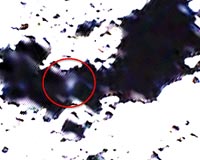 |
Oberhausen, Germany (SPX) Dec 10, 2009 The dimensions are impressive. In the spacious arena of the Gasometer Oberhausen, visitors stand under the largest Moon on Earth. The giant sculpture almost fills their entire field of vision. The balloon, with a diameter of 25 metres, appears to float in the half-light. It is a quasi-realistic reproduction of the Earth's satellite. The lighting effects show the phases of the Moon from new Moon to full Moon. Many visitors remain almost motionless for minutes. Ethereal sounds and music add to the sensory experience provided by this unique sculpture. Then we move upwards; the trip in the glass lift under the roof of the Gasometer never seems to want to end. The visitor moves further and further away from the Moon and vanishes upwards into the dark steel colossus. On reaching a height of 100 metres, the Moon-balloon, which previously seemed so enormous, appears more like a small ball. Such are the dimensions of the tallest exhibition hall in Europe. The experience of space is unique.
Our changing views of the world In addition, on the Gasometer's extensive former gas-pressure disc the visitor is able to see numerous images and exhibits from the history of astronomy: the Sky Disk of Nebra, historical telescopes, sundials, astrolabes and an armillary sphere, for example - an astronomical device for depicting the movement of heavenly bodies. They symbolise eras in the history of science and views of the world that have changed considerably. Ptolemy's ancient geocentric view of the world saw Earth and human beings at the centre of creation. This view held sway until the Middle Ages. The Copernican Revolution, one of the greatest cataclysms in intellectual history, began in the middle of the 16th century. Astronomical measuring methods and instruments were improved. Tycho Brahe, Johannes Kepler and others refined this heliocentric view of the world (with the Sun at the centre) and Copernicus' scientific explanation. Galileo Galilei, in particular, is known for the controversy regarding his teachings concerning the correct view of the world; does the Earth move around the Sun or does it remain motionless at the centre? With advancements in the astronomical knowledge-seeking process, views of the world changed - and so too did the position that humans considered that they had in the Universe, which moved away from being at the centre of everything. This is the spectrum covered in the central part of 'Out of this World'. The visitor sees Camille Flammarion's woodcut of 1888 as symbolic of curiosity and the exploratory urge; humankind breaks through its existing horizons and discovers new worlds.
Pictures of worlds near and far Other classics in the history of space travel can be experienced by visitors via headphones: for example the beeping of Sputnik, the first artificial satellite, the countdowns of various rocket launches and the 'golden record' words of greeting from the Voyager space probes that, since 1977, have been used as cosmic 'messages in a bottle'. A replica of this golden record is also on show. The stairway leads the visitor downstairs to the ground-level exhibition space. A warmly shining, Sun-like ball dominates its centre. Distributed over the almost 70-metre-wide space are the planets of our Solar System, in the form of sculptures. Among them, large-format images show our Solar System, its development and its wonderful multiformity: for example Mars, Saturn, the moons of Jupiter - Io and Europa - and Earth. Nearby, photographs of strange worlds can be seen: cosmic nebula, distant galaxies, pictures showing the birth and dying away of stars, and gas nebulae that shine like cats' eyes. The beauty of these photographs impresses all the visitors. Speechlessness and amazement are the most frequent reactions. The exhibition's popularity with the public can also be seen in the numbers of visitors. More than 425,000 people visited 'Out of this World' in its first eight months: a record for the Gasometer. For this reason, the exhibition, presented by the German Aerospace Center and the Gasometer Oberhausen GmbH, has been extended beyond the International Year of Astronomy 2009. It will be open for the whole of 2010, when the city in question will be one of the culture capitals of Europe. So there are many more 'Out of this World' experiences still to be had ... Location: Gasometer Oberhausen Opening hours: Tuesday to Sunday and on holidays: 10:00 to 18:00; closed on Mondays Admission: Adults 7 Euro, Concession 5 Euro Until: 30 December 2010 Share This Article With Planet Earth
Related Links Exhibition "Out of this World" German Aerospace Center (DLR) Mars News and Information at MarsDaily.com Lunar Dreams and more
 Researcher Delighted That LCROSS Confirms Lunar Prospector Findings
Researcher Delighted That LCROSS Confirms Lunar Prospector FindingsWashington DC (SPX) Dec 09, 2009 When the LCROSS rocket stage slammed into Cabeus crater on October 9, creating an impact plume of material that had not seen sunlight for possibly billions of years, it conclusively proved that water ice exists in the dark recesses of the Moon's polar craters. The LCROSS findings delighted William Feldman, a senior scientist at the Tucson-based Planetary Science Institute. "What got me ... read more |
|
| The content herein, unless otherwise known to be public domain, are Copyright 1995-2009 - SpaceDaily. AFP and UPI Wire Stories are copyright Agence France-Presse and United Press International. ESA Portal Reports are copyright European Space Agency. All NASA sourced material is public domain. Additional copyrights may apply in whole or part to other bona fide parties. Advertising does not imply endorsement,agreement or approval of any opinions, statements or information provided by SpaceDaily on any Web page published or hosted by SpaceDaily. Privacy Statement |